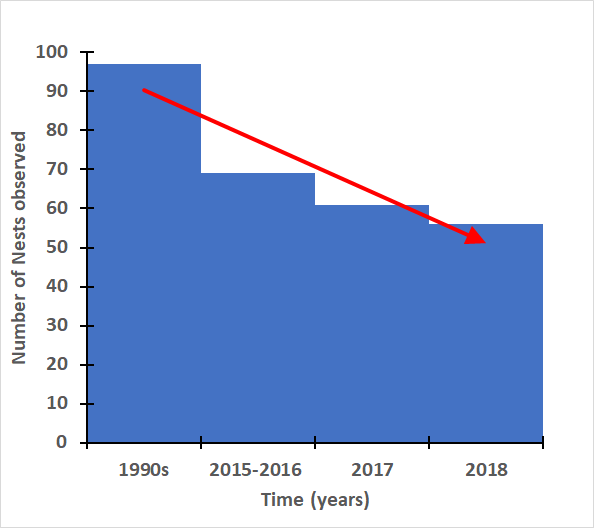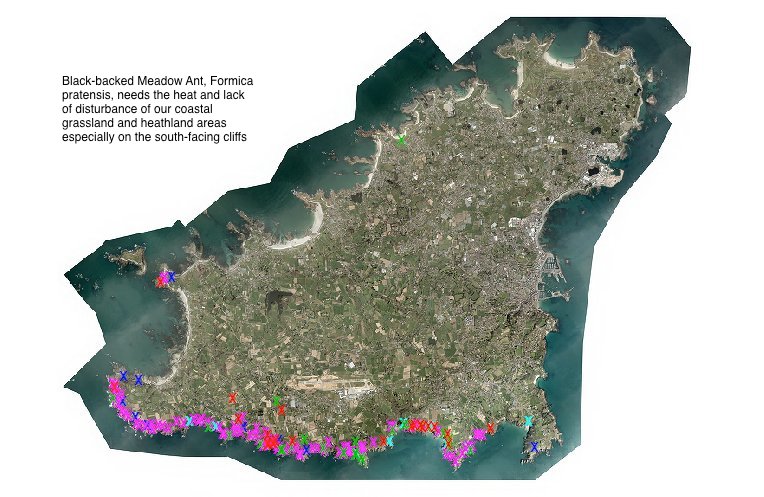Black-backed Meadow Ant Annual Survey
Some quick facts about our annual Black-backed Meadow Ant Formica pratensis survey:
Why do we care about this ant?
This species, which is native to Europe, is declining across its range and Guernsey and Jersey are now the only places where they are found within the British Isles. They are probably extinct on the mainland as no nests have been seen since the 1980s. It is classified as Near Threatened on the IUCN Red List.
Like everywhere else, the number of nest sites has been declining in Guernsey. Since the 1990s we have experienced a 42% decline in the black-backed meadow ant population in Guernsey. As a flagship species for permanent grassland and heathland, which support a wide diversity of insects and plants and attract many birds, habitat loss is a major concern.

Number of nests over time
42% decrease since the 90s!
Ant Action Plan
To combat this species decline an Action Plan was created and since 2018 we have been marking individual nests by the cliff path with red flags. If you see a flag please leave it in place, we will remove them in the autumn.
Objectives:
- To maintain and, where possible, increase viable populations of this species at its known sites.
- Targets for maintaining or increasing the populations and range:
- No further decline in nest numbers
- Increase in density of nests in areas outside the current hotspots
- Recolonization of previous known range

Black-backed meadow ant facts
- They are an indicator species for permanent grassland and heathland. They show how healthy the habitat is.
- On average, a mature nest will be home to over 60,000 ants. Most of these will be female workers.
- We have some nests that are over 20 years old.
- Each nest will have one queen - possibly more - whose job is to lay eggs.
- On a few fine days during late spring and summer, some eggs will hatch out as winged males and females. After mating, the male quickly dies. The female, now a potential queen, will fly away and will soon lose her wings. With luck, she will find a suitable place to burrow underground to start a new nest. She will begin to lay eggs that, when hatched, will be the makings of a new colony.
- They are predatory and will take a wide range of food back to the nest: earthworms, caterpillars, insects and other small creatures. Even, surprisingly, a juvenile slow-worm about six inches long was targeted in 2019 - it was rescued!
Where do the ants live?
The ants are commonest on south-facing slopes as their nests require high levels of sunshine. In Guernsey, they are found along the cliff paths between Pleinmont and Icart and in field banks close to the cliffs. There is one nest site on Lihou Headland. The nests vary in size from 25 cm to over a metre and are covered with a shallow mound of thatch – bits of dried twig and grass which help to insulate the nest. Some nests are over twenty years old! Many nests are close to the cliff paths, probably because it is open and a little warmer, which the ants prefer.“I volunteered to do a survey in 2017, knowing next to nothing about ants. Living in the Vale, it gave me a good reason to walk the cliffs. I repeated the survey in 2018, 2019 and intend to do it for a good few years to come. I love doing my bit for Guernsey’s wildlife and hope that I can help to turn the tide in the ants’ favour. I have learned so much about these social insects, but still have more questions than answers. The cliffs are beautiful whatever the weather, but to be out there on a fine Spring day when the gulls are nesting, the fulmars are flying and the ants’ nests are heaving, there’s no better place to be. I care about the Black-backed Meadow Ants because biodiversity is so important and it is under threat in our island. If you are not already a member, you might consider joining La Société Guernesiaise. It does a terrific job protecting our nature and heritage. The more members it has, the more it can do.“
What are we doing to help the ants?
Plants growing along the cliff paths have to be cut back during the growing season. States Works do two cuts every summer, starting at the end of April and finishing in September. The team do a brilliant job to cut round the nests, but it’s not always easy to see them so the red flags make it easier for them to see the nests. 2018 was particularly difficult and likely to repeat this year. After a wet spring, many of the nests can be covered with plant growth and in danger of being overwhelmed. Volunteers will cut back vegetation with secateurs and scissors to create a crown of grass and other plants and ensure the nests have optimum sunshine and remain warm and dry.
So, the flags are not, as some passers-by think, to warn people about dangerous ants, (or even, as one suggested, to mark them out for extermination!) but rather to protect them. The team have found the flags very helpful, so we have continued to flag the nests. The flags will be removed in the autumn.


